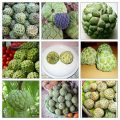Tomatoes are a beloved addition to any vegetable garden, and with the right care and helpful tips, you can enjoy a bountiful harvest of juicy, flavorful fruits. Whether you’re a seasoned gardener or a beginner, these time-tested tips will guide you towards successfully growing great-tasting tomatoes.
1. Select the Perfect Tomato Variety:
Choose the right tomato variety that suits your needs. Indeterminate tomatoes offer continuous fruiting throughout the season, while determinate tomatoes ripen all at once, making them ideal for sauces and drying. For limited garden space, consider smaller determinate varieties or go for indeterminate heirloom options for a steady summer harvest.
2 . Provide Ample Light for Thriving Tomato Seedlings
To ensure the success of your tomato seedlings, providing abundant light is essential. If you’re not cultivating them in a greenhouse, employing artificial plant lighting for 14 to 18 hours per day is your best option.
To prevent seedlings from becoming leggy and weak, maintain a distance of just a few inches between the young plants and fluorescent grow lights. As the seedlings grow, you’ll need to adjust the height of the lights or lower the plants accordingly. This measure guarantees that the seedlings receive the optimal light intensity.
When it’s time to transplant the seedlings into the garden, choose the sunniest area in your vegetable garden as their new home. Tomatoes thrive in sunlight, and to achieve vigorous growth and a bountiful harvest, they require at least 6 to 8 hours of full sun each day.
By diligently providing ample light at each stage of their growth journey, you’ll set your tomato plants up for a robust and fruitful future. Enjoy the process of cultivating these sun-loving delights and revel in the satisfaction of homegrown tomatoes bursting with flavor!
3. Promote Strong Stems with Adequate Air Circulation
To foster robust stems in your tomato plants, it’s crucial to provide them with sufficient air circulation, especially if you begin by growing seedlings indoors. While outdoor plants benefit from natural breezes, indoor seedlings require a little assistance.
One effective method is to use a fan to create a gentle breeze around the seedlings for approximately five to 10 minutes, twice a day. This artificial airflow mimics the outdoor environment and encourages sturdy stem development.
Alternatively, you can stimulate the tomato plants manually by softly rubbing your hand back and forth across the tops of the plants several times a day. This gentle ruffling imitates the effect of a breeze, prompting the plants to strengthen their stems.
By implementing these practices, you’ll be nurturing tomato plants with sturdy stems that can better withstand outdoor conditions and ultimately yield a flourishing and fruitful garden. Embrace the process of caring for your plants, and relish in the joy of watching them grow strong and healthy!
4. Ensure Optimal Soil Conditions for Thriving Tomatoes
Prioritize the right soil conditions to set the stage for successful tomato cultivation. Tomatoes thrive in slightly acidic soil, ideally with a pH ranging from 6.2 to 6.8. Before planting, it’s essential to check your soil’s pH either at home or through a soil test conducted by your local extension agency. A soil test not only reveals the pH but also identifies any potential nutrient deficiencies.
Prepare the soil by incorporating compost before planting your tomatoes. This organic matter enriches the soil, providing essential nutrients and improving its overall structure. For an extra boost of nutrition, consider side dressing your tomato plants with compost mid-season.
In addition to compost, you have the option to apply a fertilizer specially formulated for tomatoes every two weeks throughout the growing season, beginning from planting time. Tomatoes are considered heavy feeders, necessitating a consistent and ample supply of nutrients to support their growth and fruit development.
By ensuring proper soil conditions and supplying your tomatoes with the nourishment they require, you’ll be well on your way to a thriving garden filled with vibrant, flavorful tomatoes. Embrace the joy of cultivating these delightful fruits and relish the rewards of a successful harvest!
5. Timing is Crucial: Planting Tomatoes at the Right Time
The key to successful tomato cultivation lies in planting them at the appropriate time. As a rule of thumb, wait until all threats of frost in your specific growing zone have subsided and soil temperatures have risen to at least 60 degrees Fahrenheit. To ensure a smooth transition, it is advisable to hold off on planting until nighttime temperatures consistently remain above 50 degrees Fahrenheit.
For those who have started their tomato seedlings indoors, it is essential to harden them off before transplanting them outside. Hardening off is a gradual process that acclimates the tender seedlings to outdoor conditions. To do this, gradually expose the seedlings to the outdoor environment over several days, starting with short periods of time and gradually increasing the duration.
6. Offer Sturdy Support for Thriving Tomato Plants
As your tomato plants reach a height of 10 to 12 inches, it’s time to provide them with the necessary support to keep them upright and healthy throughout their growth journey. Various support options are available, such as tomato cages, string trellises, and wooden or metal stakes with ties, which effectively keep the plants properly supported.
Indeterminate tomato varieties, which continue to grow and produce fruit throughout the season, typically require stronger supports to accommodate their ongoing development. On the other hand, determinate tomato varieties can benefit from stakes or cages to help them maintain their upright posture once they bear fruit.
7. Enhance Tomato Plant Health: Prune the Bottom Leaves
As your tomato plants grow to a height of 2 to 3 feet, it’s beneficial to remove the leaves from the bottom foot of the stem. These lower leaves are typically the oldest and are more susceptible to developing fungal issues.
Since these leaves are in close proximity to the ground, they may come into contact with soil-borne pathogens, making them prone to fungal diseases. By carefully pruning them, you can help prevent the spread of potential infections and promote better overall plant health.
To ensure a hygienic process, remember to disinfect your clippers between each plant to avoid transmitting diseases from one plant to another. Additionally, consider spraying your tomato plants weekly with compost tea, a natural and nutrient-rich fertilizer that also possesses disease-fighting properties.
8.Increase Tomato Yield by Removing Suckers
Boost your tomato plant’s productivity by removing suckers that emerge in the crotch joint of two branches. When these suckers are about three inches long or smaller, pinch or prune them off. Suckers do not bear fruit and can divert valuable energy away from the main plant, impacting overall fruit production.
Additionally, consider propagating these removed suckers by rooting them in water. By doing so, you can grow new tomato plants from these cuttings, expanding your tomato garden with ease.
Managing suckers is an effective way to encourage a healthier, more fruitful tomato crop. Embrace these simple yet rewarding gardening techniques and look forward to a satisfying harvest of delicious, homegrown tomatoes.






